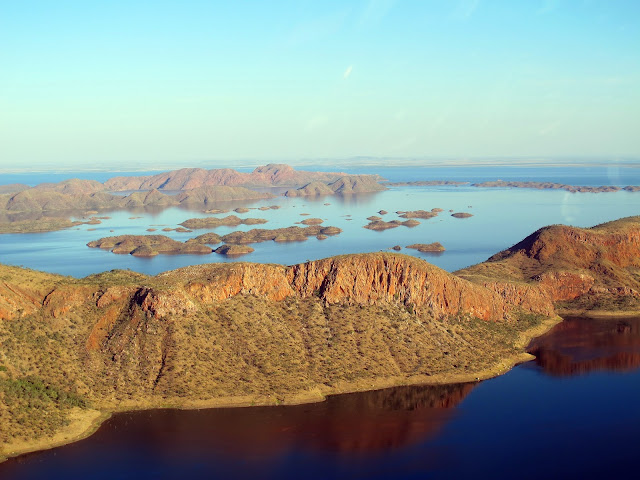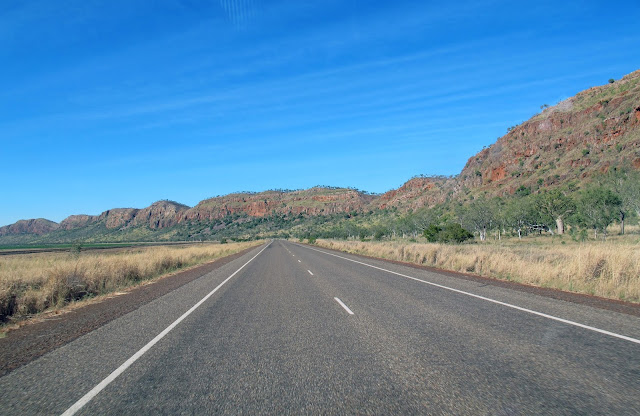The chattering of monkeys and sounds of bird call broke through the last moments of my sleep. With eyes half open, I realised that this was the last morning for many months, maybe even a year, that I would awake to the beauty of early morning at Olu Ella. Out I went to the balcony where I watched the slow sun slide through the trees and flash on the white head feathers of fantails as they darted among branches. Other birds called their friends to get moving, to begin their day long food search.
There was no need to search for food on my part! I could hear the sounds of people below me as they began preparations for our breakfast. As it was our last breakfast we were sure to be presented with an elaborate one! I decided to go down to meet the day so, after "Good Morning! "to everyone, I went down the steps to the river below. There I sat beside the calm swimming hole watching the yellow bulbuls darting to pick off the insects caught in the new sunlight. I love to sit here, feet in the quiet waters, watching the flowing water find its way through the huge rocks and becoming a fierce rush of white water just a few metres downstream.
I knew that today this beautiful place would be enjoyed by city dwellers making a weekend escape from the pollution of Colombo by visiting our guesthouse -home to play in the river, enjoying the cool, refreshing water before sampling the traditionally cooked dishes that have earned the guesthouse many recommendations.
I decided to leave the river today for our visitors to enjoy and made plans to spend the day with a slow trip down the road stopping to take photos at my favourite points. Usually, when we leave home we are moving to a timetable and there's no time to stop for photos. Today I would go alone and stop wherever I pleased! A phone call confirmed that a tuk tuk was available so, after breakfast of freshly made egg hoppers - always my favourite Sri Lankan breakfast - I took my camera and walked down our path to the bridge.
Set among the tea and rubber trees our home is in a hill side village where tea and rubber, together with cardamons and cloves in season, are the income earners for the villagers.
Then it was a practiced walk over the high bridge . . .
. . . with a pause to take a photo looking downstream . . .
and upstream.
About five hundred metres along the road is Olu Ella Falls, the fifth highest waterfall in Sri Lanka. I have posted previously about this waterfall.
My tuk tuk was waiting! The young driver had been told that I wanted to take photos so, after only my first request to stop, he took to stopping wherever he thought a photo should be taken. He really loved his part of the world and stopped exactly where I planned!
For the most part, the road is little more than one way only. We are all used to this and there's absolutely no road rage when there are delays with vehicles needing to back up. Instead people use the opportunity to shout news from passing tuk tuks or buses to friends going the other direction!
First time visitors to our guesthouse often remark that just getting to our place is an adventure! They enjoy the drive along the windy road, adventures at every corner, through the tea and rubber plantations and the vistas that greet them at every bend.
Tea is everywhere. As the people usually have only a couple of acres of tea to farm the daily pick is collected by the local tea factories. How much per kilogram they are paid for these green leaves depends on the season but is usually between fifty to sixty rupees a kilogram. The pickers are paid about ten rupees per kilogram for their work so a lot of tea needs to be picked for anyone to earn a living.
Harvesting both tea and rubber is very much dependent on the weather. If there's rain, harvesting is impossible. In recent years there have been very long periods of drought in this area and the people have suffered accordingly. No harvesting equals no income.
When I made my first trip along this road almost fifty years ago I was shocked to see cows little bigger than big dogs. Coming from New Zealand, this horrified me. Now, with breeding assistance from New Zealand, the cows I meet are very much bigger! And can be somewhat intimidating! This one did not agree to having her photo taken.
This area is in a rain corridor so, even on a day that starts out clear and sunny, clouds can appear and dump a bit of water before petering out and returning the sunshine. The hilltops often sit in front of a haze.
In the wet season the hills are adorned with many high waterfalls. This year I noted that most had dried up, including some I have never known to do so.
What a beautiful setting for the We Oya Rubber Estate's workers' accommodation!
All too soon it was time to turn around. A phonecall informed me that the visitors had finished their water fun. My turn now!
I was soon back in the water, fish exploring around my feet looking for something to eat. . .
. . . and watching the Asian Open Billed stork feeding from the rocks.
What a lovely way to end my time in my Sri Lankan home!
 |
| Olu Ella Inn balcony |
I knew that today this beautiful place would be enjoyed by city dwellers making a weekend escape from the pollution of Colombo by visiting our guesthouse -home to play in the river, enjoying the cool, refreshing water before sampling the traditionally cooked dishes that have earned the guesthouse many recommendations.
 |
| Visitors enjoying the We Oya at Olu Ella Ella Inn |
 |
| Our Sri Lankan home. Olu Ella Inn |
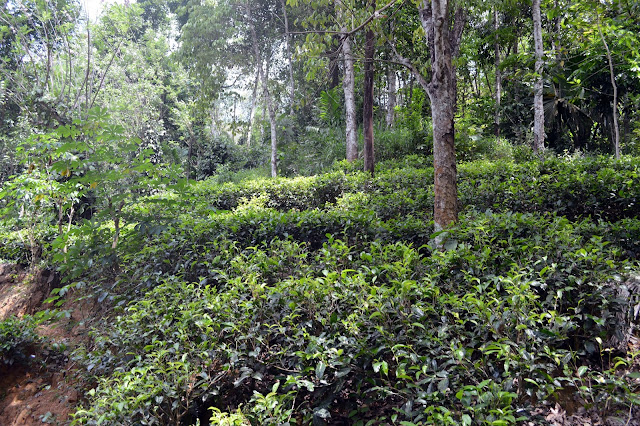 |
| Tea and Ribber trees |
 |
| Bridge over We Oya, at Dombepola |
. . . with a pause to take a photo looking downstream . . .
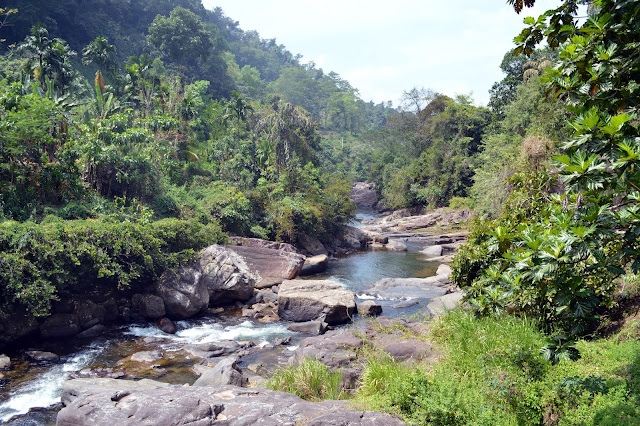 |
| Down stream We Oya from Dombepola bridge |
and upstream.
 |
| upstream We Oya, Dombepola bridge and after heavy rain. |
 |
| Olu Ella Falls, wet season |
 |
| Olu Ella Falls, dry season |
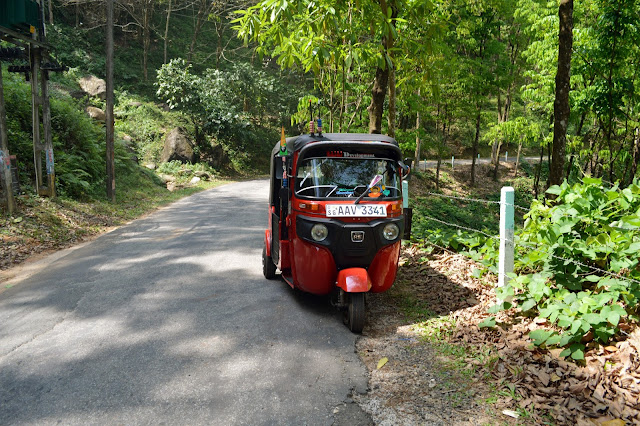 |
| Travel by tuk tuk |
 |
| Seepoth Road, from Yatiyantota |
 |
| Getting the day's tea pick ready for collection |
 |
| Rubber trees, We Oya |
 |
| Collecting the latex. |
This area is in a rain corridor so, even on a day that starts out clear and sunny, clouds can appear and dump a bit of water before petering out and returning the sunshine. The hilltops often sit in front of a haze.
 |
| We Oya valley |
 |
| Water falls We Oya |
 |
| We Oya Rubber Estate |
I was soon back in the water, fish exploring around my feet looking for something to eat. . .
 |
| Asian Open Bill, Sri Lanka |
 |
| Asian Open Bill, We Oya, Sri Lanka |
 |
| We Oya, Sri Lanka |















